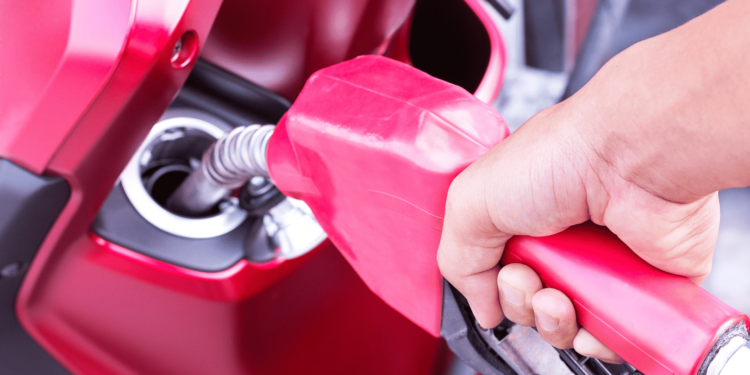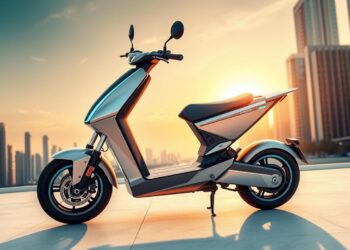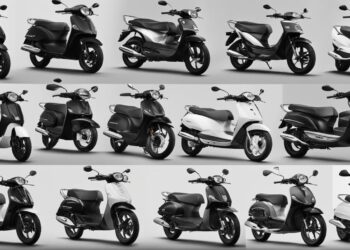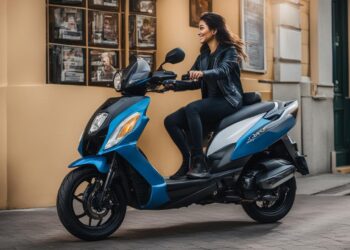Welcome to the ultimate Scooter Fuel Mileage Guide, where I will share valuable insights and tips on how to improve your scooter’s fuel efficiency and save money on your daily rides.
Key Takeaways:
- Scooter fuel mileage is determined by the engine displacement, with larger engines consuming more fuel.
- A 50cc scooter can travel about 40 miles per hour and gets an average of 110 miles per gallon.
- A 125cc scooter gets around 95 miles per gallon.
- A 150cc scooter can travel 60 miles per hour and gets about 70 miles per gallon.
- Scooters with engine sizes above 250cc have lower fuel efficiency.
- It is recommended to use higher octane gas for modern scooters.
- Practicing fuel-saving habits like using the accelerator wisely and maintaining tire pressure can improve fuel efficiency.
In this comprehensive Scooter Fuel Mileage Guide, I will provide you with all the information you need to maximize your scooter’s fuel efficiency. From understanding the factors that affect fuel consumption to implementing fuel-saving tips, this guide will help you save money on your daily commute.
Table of Contents
- Understanding Scooter Fuel Efficiency
- Engine Displacement and Fuel Consumption
- Scooter Mileage Comparison: 50cc, 125cc, and 150cc
- Tips to Maximize Scooter Fuel Efficiency
- Fuel Options for Eco-Friendly Scooter Riders
- Importance of Proper Scooter Maintenance
- Tire Pressure and Fuel Efficiency
- Maximizing Fuel Efficiency through Accelerator Usage
- Benefits of Scooter Fuel Efficiency
- Conclusion
- FAQ
Understanding Scooter Fuel Efficiency
To make informed decisions about improving your scooter’s fuel efficiency, it’s crucial to understand the workings of scooter engines and how they impact fuel consumption. Scooter fuel efficiency is primarily determined by the engine displacement, which refers to the size and power output of the engine.
In general, larger engines consume more fuel compared to smaller engines. A 50cc scooter, for example, is known for its impressive mileage, capable of traveling around 40 miles per hour and getting an average of 110 miles per gallon. On the other hand, a 125cc scooter offers around 95 miles per gallon, while a 150cc scooter, with its higher speed capability of 60 miles per hour, achieves approximately 70 miles per gallon.
| Engine Size | Mileage (MPG) |
|---|---|
| 50cc | 110 |
| 125cc | 95 |
| 150cc | 70 |
It’s important to note that scooter models with engine sizes above 250cc tend to have lower fuel efficiency. Therefore, if maximizing fuel economy is a priority for you, it’s advisable to opt for a scooter with a smaller engine size.
In addition to engine displacement, there are other factors that can impact scooter fuel efficiency, including the octane rating of the gasoline used and the maintenance practices employed. Using higher octane gas designed for modern scooters can enhance performance and fuel economy. Implementing fuel-saving habits, such as using the accelerator wisely and maintaining proper tire pressure, can also contribute to improved fuel efficiency.
Summary
- Scooter fuel efficiency is determined by the engine displacement.
- Larger engines consume more fuel compared to smaller engines.
- A 50cc scooter can achieve around 110 miles per gallon.
- A 125cc scooter offers approximately 95 miles per gallon.
- A 150cc scooter can travel at higher speeds, around 60 miles per hour, and gets about 70 miles per gallon.
- Scooters with engine sizes above 250cc tend to have lower fuel efficiency.
- Using higher octane gas and practicing fuel-saving habits can enhance scooter fuel efficiency.
Engine Displacement and Fuel Consumption
Engine displacement plays a significant role in determining a scooter’s fuel consumption, and understanding this relationship will help you make informed decisions when choosing a scooter. Generally, scooters with larger engines consume more fuel compared to those with smaller engines. This is because larger engines require more power to operate, resulting in increased fuel consumption.
When considering fuel efficiency, it’s important to know that engine size is measured in cubic centimeters (cc). The most common scooter engine sizes range from 50cc to 150cc. A 50cc scooter, for example, can reach speeds of around 40 miles per hour and achieve an average of 110 miles per gallon.
For those looking for a balance between power and fuel economy, a 125cc scooter can provide a good option. With an average fuel consumption of around 95 miles per gallon, these scooters offer a decent combination of performance and efficiency.
On the other hand, if speed is a priority and fuel consumption is less of a concern, a 150cc scooter might be the right choice. These scooters can reach speeds of up to 60 miles per hour, but their fuel efficiency drops to around 70 miles per gallon due to the larger engine size.
| Engine Size | Speed | Fuel Efficiency |
|---|---|---|
| 50cc | 40 mph | 110 mpg |
| 125cc | N/A | 95 mpg |
| 150cc | 60 mph | 70 mpg |
It’s worth noting that scooters with engine sizes larger than 250cc tend to have lower fuel efficiency. Therefore, if fuel economy is a top priority for you, it’s recommended to choose a scooter with a smaller engine size.
To optimize fuel consumption and get the most out of each tank of fuel, there are some fuel-saving tips you can follow. Using the accelerator wisely, avoiding unnecessary speed fluctuations, and maintaining proper tire pressure can significantly improve your scooter’s fuel efficiency. Additionally, using higher octane gasoline designed for modern scooters can also help maximize fuel economy.

Scooter Mileage Comparison: 50cc, 125cc, and 150cc
Let’s compare the fuel efficiency of three popular scooter engine sizes: 50cc, 125cc, and 150cc, to help you make an informed decision when purchasing a scooter.
As you consider the fuel economy of different scooters, it’s important to note that scooter mileage can vary based on various factors such as riding conditions, rider weight, and maintenance. However, we can still provide you with a general overview of the average mileage you can expect from each engine size.
A 50cc scooter, equipped with a small engine, can typically travel at speeds up to 40 miles per hour and delivers an impressive average of 110 miles per gallon (mpg). This makes it an excellent choice for urban commuting, offering both efficiency and cost-effectiveness.
If you’re looking for slightly more power without sacrificing fuel efficiency, a 125cc scooter might be the right fit for you. With an average fuel consumption of around 95 mpg, these scooters strike a good balance between performance and economy.
| Engine Size | Maximum Speed | Average Mileage (mpg) |
|---|---|---|
| 50cc | Up to 40 mph | 110 |
| 125cc | Varies | 95 |
| 150cc | Up to 60 mph | 70 |
For those seeking a higher top speed, a 150cc scooter may be preferable. These scooters can reach speeds of up to 60 miles per hour while still delivering a respectable average of 70 mpg. However, it’s important to note that as engine size increases above 150cc, fuel efficiency tends to decrease.
When it comes to fuel efficiency, smaller engine sizes generally offer better mileage. However, it’s worth considering your specific needs and usage patterns to determine which engine size is the best fit for you. Whether you prioritize speed, economy, or a combination of both, there is a scooter option available to suit your preferences.
Tips to Maximize Scooter Fuel Efficiency
To maximize your scooter’s fuel efficiency, it’s important to adopt certain habits and practices that optimize fuel consumption. Implementing these fuel-saving tips will not only save you money but also contribute to a greener environment. Here are some tried and tested tips to help you get the most mileage out of each tank of fuel:
- Maintain proper tire pressure: Ensuring that your scooter’s tires are properly inflated can significantly improve fuel efficiency. Underinflated tires create more rolling resistance, which requires more energy (fuel) to move the scooter forward. Regularly check your tire pressure and inflate them to the recommended levels for optimal fuel economy.
- Practice smooth acceleration: A heavy hand on the accelerator can quickly drain your scooter’s fuel tank. Instead, focus on smooth and gradual acceleration to conserve fuel. Avoid unnecessary speed fluctuations and sudden bursts of acceleration. By maintaining a steady speed, you’ll not only save fuel but also prolong the lifespan of your scooter’s engine.
- Limit idling time: Leaving your scooter’s engine running while stationary wastes fuel unnecessarily. If you anticipate being stationary for more than a minute, it’s best to turn off the engine. This simple habit can go a long way in reducing fuel consumption and emissions.
- Keep up with regular maintenance: Proper maintenance plays a crucial role in optimizing fuel efficiency. Regularly servicing your scooter, including oil changes, filter replacements, and spark plug checks, ensures that your engine operates at its best. A well-maintained engine consumes less fuel and performs more efficiently.
It’s All About Efficiency
Remember, every drop of fuel counts when it comes to maximizing your scooter’s fuel efficiency. Small changes in your riding habits and regular maintenance practices can add up to significant fuel savings over time.
By implementing these fuel-saving tips, you’ll not only save money but also reduce your carbon footprint. So go ahead, adopt these practices, and enjoy a more efficient and eco-friendly commute on your scooter!
| Engine Size | Approximate Speed | Average Mileage (MPG) |
|---|---|---|
| 50cc | 40 mph | 110 |
| 125cc | N/A | 95 |
| 150cc | 60 mph | 70 |
| Above 250cc | N/A | Lower fuel efficiency |
These figures provide a general idea of the average mileage you can expect from scooters of different engine sizes. However, it’s important to note that individual riding habits, road conditions, and maintenance practices can also impact fuel efficiency. By implementing the fuel-saving tips mentioned earlier, you can further optimize your scooter’s mileage.
Fuel Options for Eco-Friendly Scooter Riders
If you’re passionate about reducing your carbon footprint, exploring eco-friendly fuel options for your scooter is a step in the right direction. By opting for cleaner and more sustainable fuel choices, you can contribute to a greener environment while enjoying the convenience of your scooter. Let’s take a closer look at some eco-friendly fuel options available for scooter riders.
Bioethanol
One alternative fuel option for scooters is bioethanol. Derived from renewable sources such as corn or sugarcane, bioethanol is a cleaner-burning fuel that reduces greenhouse gas emissions. Scooters equipped with FlexFuel technology can run on a blend of gasoline and bioethanol, providing a more environmentally friendly option for riders.
Electric Scooters
Electric scooters, powered by rechargeable batteries, are gaining popularity as a sustainable transportation option. These scooters produce zero tailpipe emissions, reducing air pollution and dependence on fossil fuels. With advancements in battery technology, electric scooters offer increased range and improved performance, making them a viable eco-friendly option.
Hydrogen Fuel Cell Scooters
Another promising eco-friendly fuel option is hydrogen fuel cell scooters. These scooters use a fuel cell to convert hydrogen gas into electricity, which powers the scooter’s motor. Hydrogen fuel cell scooters emit only water vapor, making them a zero-emission alternative with the added benefit of quick refueling times.
“By opting for cleaner and more sustainable fuel choices, you can contribute to a greener environment while enjoying the convenience of your scooter.”
It’s important to note that availability and infrastructure for these alternative fuel options may vary depending on your location. Before considering a fuel switch, research local fueling stations and the compatibility of your scooter with different fuel types. Additionally, keep in mind that the energy sources used to produce the electricity or hydrogen for these fuels can still have an environmental impact, so it’s essential to consider the entire life cycle of the fuel.
| Fuel Option | Advantages | Considerations |
|---|---|---|
| Bioethanol | Renewable, reduces emissions | Availability, compatibility |
| Electric Scooters | Zero emissions, improved battery technology | Charging infrastructure |
| Hydrogen Fuel Cell Scooters | Zero emissions, quick refueling | Hydrogen infrastructure |
When considering eco-friendly fuel options for your scooter, it’s essential to weigh the advantages and considerations of each fuel type. Whether you opt for bioethanol, electric scooters, hydrogen fuel cell scooters, or another alternative fuel, making a conscious choice can make a positive impact on the environment and contribute to a more sustainable future.
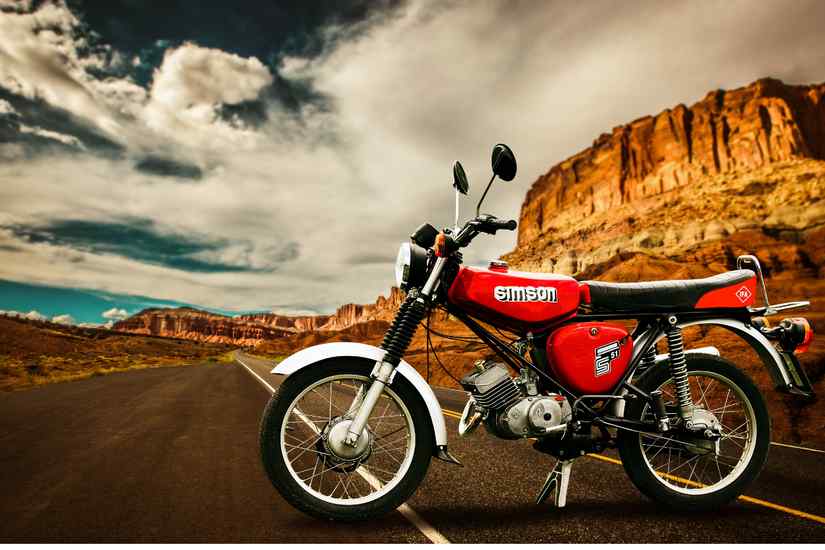
Importance of Proper Scooter Maintenance
Proper maintenance is essential for ensuring your scooter’s optimal performance and fuel efficiency. Regular servicing and upkeep play a crucial role in prolonging the lifespan of your scooter and maximizing its fuel economy. By following a few simple maintenance practices, you can enjoy a smooth ride while saving money on fuel.
One important aspect of scooter maintenance is keeping the engine well-tuned. A well-maintained engine performs more efficiently, resulting in improved fuel consumption. Regularly check and change the engine oil, replace air filters, and inspect spark plugs to keep your scooter’s engine running smoothly.
In addition to engine maintenance, proper tire pressure is another key factor in enhancing your scooter’s fuel efficiency. Maintaining optimal tire pressure not only ensures better handling and safety but also reduces fuel consumption. Always refer to your scooter’s manual for the recommended tire pressure, and regularly check and adjust it accordingly.
| Maintenance Practices for Improved Scooter Fuel Efficiency |
|---|
| Regularly service and tune the engine |
| Change engine oil and replace air filters as recommended |
| Inspect and replace spark plugs when necessary |
| Maintain optimal tire pressure |
| Follow manufacturer’s guidelines for tire pressure |
| Check and adjust tire pressure regularly |
Furthermore, practicing fuel-saving habits can significantly improve your scooter’s fuel efficiency. Avoid unnecessary speed fluctuations, use the accelerator wisely, and maintain a steady speed whenever possible. These simple techniques can help conserve fuel and reduce consumption during your rides.
By prioritizing proper maintenance and adopting fuel-saving habits, you can maximize your scooter’s fuel efficiency and enjoy cost-effective and eco-friendly rides. Remember, a well-maintained scooter not only saves you money but also contributes to a greener environment.
Tire Pressure and Fuel Efficiency
Maintaining the correct tire pressure is not only crucial for your safety but also plays a significant role in maximizing your scooter’s fuel efficiency. When your tires are properly inflated, it reduces rolling resistance and allows your scooter to glide smoothly, which ultimately conserves fuel. On the other hand, underinflated or overinflated tires can lead to increased fuel consumption and decreased mileage.
So, how do you ensure that your scooter’s tires have the optimal pressure? Firstly, always refer to your scooter’s manual or the manufacturer’s recommendations for the correct tire pressure. These guidelines will provide you with the specific PSI (pounds per square inch) range that you should maintain. Use a reliable tire pressure gauge to regularly check and adjust the pressure accordingly.
Additionally, keep in mind that tire pressure can fluctuate with changes in temperature. As the weather gets colder, tire pressure tends to decrease. Therefore, it’s essential to monitor and adjust your tire pressure more frequently during the winter months. A small investment of time in regularly checking your scooter’s tire pressure can go a long way in improving fuel efficiency and overall performance.
Recommended Tire Pressure for Common Scooter Engine Sizes
| Engine Size | Recommended Tire Pressure (front/rear) |
|---|---|
| 50cc | 25 PSI / 32 PSI |
| 125cc | 26 PSI / 33 PSI |
| 150cc | 28 PSI / 36 PSI |
These recommended tire pressures are general guidelines and may vary depending on the specific make and model of your scooter. Always consult your scooter’s manual or the manufacturer’s recommendations for the most accurate information.
Maintaining the optimal tire pressure not only improves fuel efficiency but also enhances handling and overall performance. With the right tire pressure, you can enjoy a smooth ride while saving on fuel costs. Remember to regularly check your scooter’s tire pressure, especially before long journeys, to ensure you’re getting the most out of your scooter’s fuel efficiency.
Maximizing Fuel Efficiency through Accelerator Usage
Optimizing your scooter’s fuel efficiency requires conscious control of your accelerator usage, and in this section, I’ll provide you with techniques to make the most of each drop of fuel.
One of the key tips for improving your scooter’s fuel efficiency is to avoid unnecessary speed fluctuations. Rapid acceleration and sudden braking can significantly increase fuel consumption. Instead, try to maintain a consistent speed and anticipate traffic conditions to avoid sudden stops or starts. By driving smoothly and steadily, you can conserve fuel and maximize your scooter’s mileage.
Another technique to enhance fuel efficiency is to resist the temptation to excessively rev your scooter’s engine. Revving the engine unnecessarily not only wastes fuel but also puts additional strain on the engine, leading to increased wear and tear. By keeping the engine at a moderate rpm range, you can ensure optimal fuel consumption and prolong the lifespan of your scooter’s engine.
Properly managing your scooter’s accelerator is also crucial for fuel efficiency. Instead of constantly holding the accelerator at maximum throttle, try to find a balance by gradually increasing speed and then maintaining a consistent pace. This allows the engine to operate at its most fuel-efficient level, resulting in better mileage and reduced fuel consumption.
| Techniques to Maximize Scooter Fuel Efficiency: |
|---|
| Avoid unnecessary speed fluctuations |
| Avoid excessive engine revving |
| Gradually increase speed and maintain a consistent pace |
By implementing these accelerator usage techniques, you can enhance your scooter’s fuel efficiency and get the most out of every tank of fuel. Remember, small adjustments to your driving habits can make a significant difference in both your savings and your impact on the environment.
Benefits of Scooter Fuel Efficiency
Understanding the benefits of having a fuel-efficient scooter will motivate you to implement the strategies shared in this guide and enjoy the advantages they bring. Not only will a fuel-efficient scooter save you money at the pump, but it also offers several other significant benefits.
Firstly, fuel-efficient scooters help you reduce your carbon footprint and contribute to a greener environment. By consuming less fuel, these scooters emit fewer greenhouse gases and pollutants, making them a more eco-friendly transportation option. You can feel good knowing that your daily commute is not only cost-effective but also environmentally conscious.
Secondly, fuel efficiency translates into financial savings. With the rising costs of fuel, riding a scooter that boasts good mileage can help you save a significant amount of money in the long run. Whether you use your scooter for daily commuting or occasional rides, the savings on fuel expenses can add up over time.
Additionally, a fuel-efficient scooter offers convenience and flexibility. With fewer trips to the gas station, you’ll spend less time refueling and more time enjoying the open road. You’ll also have the peace of mind knowing that you can travel longer distances without worrying about running out of fuel.
| Engine Size | Average MPG | Top Speed |
|---|---|---|
| 50cc | 110 | 40 mph |
| 125cc | 95 | N/A |
| 150cc | 70 | 60 mph |
“A fuel-efficient scooter not only saves money on fuel expenses but also reduces your carbon footprint and offers convenience and flexibility.”
To achieve optimal fuel efficiency, it is recommended to practice fuel-saving habits such as using the accelerator wisely and maintaining proper tire pressure. By following the tips outlined in this guide, you can maximize your scooter’s mileage and enjoy the benefits that come with a fuel-efficient ride.
Conclusion
Congratulations, you have reached the end of this comprehensive Scooter Fuel Mileage Guide! Now armed with valuable insights and practical tips, you are well-equipped to maximize your scooter’s fuel efficiency and enjoy a cost-effective and eco-friendly commute.
Throughout this guide, we have explored the factors that affect scooter fuel consumption and the strategies you can implement to save money on your daily rides. By understanding the relationship between engine displacement and fuel efficiency, you can make informed decisions when choosing the right scooter for your needs.
Remember, a 50cc scooter can travel approximately 40 miles per hour and achieve an average of 110 miles per gallon. On the other hand, a 125cc scooter gets around 95 miles per gallon, while a 150cc scooter can reach speeds of 60 miles per hour and achieves about 70 miles per gallon. It’s worth noting that scooters with engine sizes above 250cc generally have lower fuel efficiency.
To maximize your scooter’s fuel efficiency, consider using higher octane gas for modern scooters and following fuel-saving habits such as using the accelerator wisely and maintaining optimal tire pressure. These small changes can make a big difference in reducing fuel consumption and saving you money in the long run.
Overall, scooters are known for their good mileage and fuel efficiency. By prioritizing fuel economy and implementing the tips and techniques shared in this guide, you can enjoy a cost-effective and eco-friendly commute, while also contributing to a greener environment.
FAQ
Q: What factors affect scooter fuel mileage?
A: Scooter fuel mileage is primarily determined by the engine displacement. Larger engines consume more fuel, resulting in lower mileage. Other factors that can affect fuel mileage include the weight of the scooter and rider, riding conditions, and maintenance practices.
Q: How many miles per gallon does a 50cc scooter get?
A: On average, a 50cc scooter can travel around 110 miles per gallon. This makes them highly fuel-efficient options for daily commuting and short trips.
Q: How does a 125cc scooter compare in terms of fuel efficiency?
A: A 125cc scooter can get around 95 miles per gallon, which is slightly lower than the mileage of a 50cc scooter. However, it still offers excellent fuel efficiency and is suitable for longer distance rides.
Q: What about a 150cc scooter?
A: A 150cc scooter can travel at speeds up to 60 miles per hour and gets approximately 70 miles per gallon. While it offers higher speeds, its fuel efficiency is lower compared to smaller engine sizes.
Q: Do scooters with engine sizes above 250cc have good fuel efficiency?
A: Scooters with engine sizes above 250cc generally have lower fuel efficiency. They consume more fuel due to their larger engines and higher power output.
Q: What type of gasoline should I use for my scooter?
A: It is recommended to use higher octane gas (usually 91 or higher) for modern scooters. This can help maintain the engine performance and optimize fuel combustion.
Q: What fuel-saving habits can I practice to improve my scooter’s mileage?
A: To improve fuel efficiency, you can practice fuel-saving habits such as using the accelerator wisely, avoiding unnecessary speed fluctuations, and maintaining proper tire pressure. These practices can help reduce fuel consumption and maximize your scooter’s mileage.

